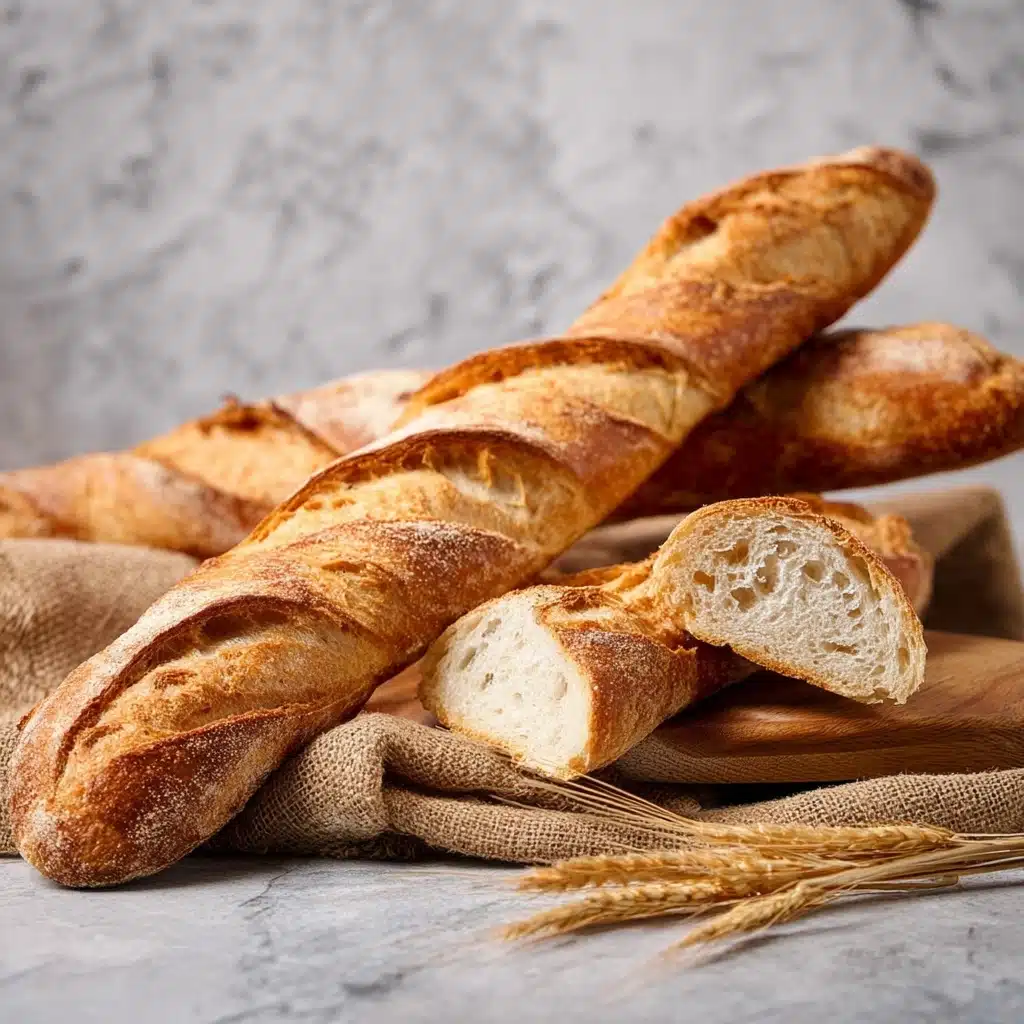Homemade Baguette Recipe
If you’ve ever dreamed of tasting the perfect crusty, golden baguette fresh out of the oven, you’re in for a real treat with this Homemade Baguette Recipe. This recipe captures the magic of traditional French baking while welcoming you into the warm world of artisanal bread making right in your kitchen. From the simple yet precise ingredients to the slow fermentation that develops deep flavor, you’ll fall in love bite after bite. There’s something truly special about crafting your own baguette from scratch—the crackling crust and tender crumb feel infinitely more rewarding when baked with your own hands.

Ingredients You’ll Need
Making an authentic baguette might sound fancy, but the ingredients are wonderfully straightforward and each one plays a crucial role in giving the bread its signature texture and flavor. The magic really starts with quality flour and pure yeast, plus a bit of patience during fermentation.
- All-purpose flour (3 1/2 cups / 420g): The foundation of your baguette, providing structure and a tender crumb when combined correctly.
- Salt (1 1/4 teaspoons): Enhances flavor and controls yeast activity to ensure a balanced rise.
- Sugar (1 teaspoon): Just a touch to feed the yeast and encourage that perfect fermentation.
- Active dry yeast (1 packet / 2 1/4 teaspoons): The living ingredient that gives the dough life and rise.
- Warm water (1 1/2 cups / 360ml at about 110°F / 43°C): Activates the yeast and helps develop the dough’s silky texture.
- Cornmeal or flour for dusting: Ensures your baguette won’t stick to the baking surface and adds a rustic touch.
How to Make Homemade Baguette Recipe
Step 1: Making the Dough
Start by combining your dry ingredients—flour, salt, and sugar—in a large bowl to create a balanced base. In a separate small bowl, activate your yeast by dissolving it in warm water. Wait for the yeast to bubble up and become foamy, which signals it’s ready to work its magic. Pour this yeast mixture into your dry ingredients and stir them together until you have a shaggy dough.
Next, turn the dough onto a floured surface and knead for 8 to 10 minutes until it feels smooth and elastic. If you prefer a hands-off approach, a stand mixer fitted with a dough hook will do the job in about 6 to 8 minutes.
Shape your dough into a neat ball, place it in a greased bowl, cover it tightly, and let it rise at room temperature until doubled in size. This usually takes about 1 to 1.5 hours and is essential for the baguette’s airy texture.
Step 2: Slow Fermentation
For an exceptional depth of flavor, transfer your risen dough to the refrigerator for 8 to 12 hours. This cold fermentation period is what truly transforms your baguette from ordinary to extraordinary by allowing natural flavors to develop gradually and making the dough easier to handle.
If you’re short on time, skipping this step is okay, but patience here results in a noticeably richer and more nuanced bread.
Step 3: Shaping the Baguettes
Once your dough has had its overnight rest, take it out of the fridge and let it warm to room temperature for about half an hour. Gently place the dough onto a floured surface and divide it into two or three equal parts based on whether you want longer or shorter baguettes.
Shape each piece into a rectangle. Then fold the long edges towards the center like a letter and pinch the seam tightly. Roll the dough gently into a long rope about 12 to 14 inches, tapering the ends just slightly to get that classic baguette look.
Place each loaf onto a parchment-lined baking sheet dusted with cornmeal or flour to prevent sticking. Cover with a clean towel and give your baguettes another rise for 45 to 60 minutes until they’re puffed and ready to bake.
Step 4: Scoring and Baking
Preheat your oven to a blistering 475°F (245°C). Place a cast iron skillet or metal pan on the oven’s bottom rack so it heats along with the oven. This will help you create the essential steam that forms the baguette’s crispy crust.
Using a sharp knife or lame, score each baguette with 3 to 4 diagonal slashes. These cuts allow the bread to expand beautifully as it bakes.
Right before putting the loaves in the oven, pour about one cup of hot water into the preheated skillet and quickly close the door to trap steam. Bake your baguettes for 20 to 25 minutes until they’re a deep golden brown and sound hollow when tapped on the bottom. Cooling on a wire rack is a must—if you can resist slicing into them right away!
How to Serve Homemade Baguette Recipe

Garnishes
A freshly baked baguette is a work of art on its own, but a light brush of melted butter or a sprinkle of flaky sea salt can elevate it even more. You can also rub the crust with a cut garlic clove for a subtle, inviting aroma before serving.
Side Dishes
Nothing complements a warm baguette better than classic French accompaniments like rich cheeses, pâté, or a bowl of steaming soup. It’s wonderful alongside roasted vegetables or as part of a charcuterie board with olives and cured meats.
Creative Ways to Present
Slice your baguette and toast it lightly for crunchy crostini, perfect for topping with bruschetta or creamy spreads. You can even hollow out small sections to make mini bread bowls for dips or salads, transforming simple bread into a delightful centerpiece.
Make Ahead and Storage
Storing Leftovers
If you have leftover baguette, store it loosely wrapped in a paper bag or linen bread bag at room temperature for up to two days. Avoid plastic bags as they trap moisture and soften the crust.
Freezing
Baguettes freeze beautifully. Wrap the cooled bread tightly in plastic wrap, then place it inside a freezer bag. When you want to enjoy it, thaw the baguette at room temperature or straight in the oven for a few minutes to refresh the crust.
Reheating
To revive the baguette’s crunch and warmth, preheat your oven to 350°F (175°C) and bake the baguette for 5 to 10 minutes. You’ll get that fresh-from-the-bakery experience all over again!
FAQs
Can I use bread flour instead of all-purpose flour?
Absolutely! Bread flour has a higher protein content and will give your baguettes a chewier texture with a slightly more robust crust. Either flour will work, so choose based on your preference.
What if I don’t have a cast iron skillet to create steam?
No worries! Any metal pan or baking dish that can hold hot water will do. Just be sure to place it in the oven before preheating to get it nice and hot, which is key for that steamy crust.
How important is the slow fermentation step?
While you can skip the overnight rest, the slow fermentation significantly improves flavor complexity and gives the dough better handling qualities. It’s a highly recommended step if you have the time.
Can I make smaller baguettes or rolls with this dough?
Yes! This dough is versatile and can be divided into more pieces for smaller baguettes or shaped into rolls. Just adjust the baking time accordingly so they don’t overbrown.
Why does the recipe call for sugar in a savory bread?
Sugar feeds the yeast and helps kickstart fermentation, which leads to a better rise and improved texture. The amount used is minimal and won’t make the bread taste sweet.
Final Thoughts
There’s something truly magical in baking your own bread, and this Homemade Baguette Recipe is a wonderful place to start that journey. With just a handful of simple ingredients and a bit of patience, you can bring the irresistible aroma and flavor of fresh French bread right into your home. So, why not give it a try and impress your loved ones with baguettes that taste like they came straight from a Parisian bakery?
PrintHomemade Baguette Recipe
This homemade baguette recipe guides you through making authentic, crusty French bread at home using traditional methods. With a slow fermentation process and careful shaping, you achieve a delicious baguette with a crisp crust and airy crumb. Perfect for sandwiches, alongside soups, or enjoyed with butter.
- Prep Time: 20 minutes
- Cook Time: 25 minutes
- Total Time: 10 hours (including 8-12 hours cold fermentation and rises)
- Yield: 2–3 baguettes 1x
- Category: Bread
- Method: Baking
- Cuisine: French
- Diet: Vegetarian
Ingredients
Main Ingredients
- 3 1/2 cups (420g) all-purpose flour
- 1 1/4 teaspoons salt
- 1 teaspoon sugar
- 1 packet (2 1/4 teaspoons) active dry yeast
- 1 1/2 cups (360ml) warm water (about 110°F / 43°C)
For Baking
- Cornmeal or flour for dusting
Instructions
- Make the Dough: In a large bowl, combine the flour, salt, and sugar. Dissolve the yeast in warm water and wait until foamy, about 5–10 minutes. Pour into the dry ingredients and mix until a shaggy dough forms. Knead on a floured surface for 8–10 minutes or use a stand mixer with a dough hook for 6–8 minutes until smooth and elastic. Shape into a ball and place in a greased bowl, covering with plastic wrap. Let rise at room temperature until doubled, about 1 to 1.5 hours.
- Slow Fermentation: For optimal flavor, refrigerate the risen dough overnight (8–12 hours). This cold fermentation enhances flavor complexity and dough handling. If short on time, you may skip this step but expect less flavor depth.
- Shape the Baguettes: Remove dough from fridge and let rest at room temperature for 30 minutes. Turn out onto a floured surface and divide into two or three equal pieces. Roll each piece into a rectangle, fold the long sides inward like a letter, pinch seam, and roll into 12–14 inch ropes with tapered ends. Place on parchment-lined baking sheet dusted with cornmeal or flour. Cover and let rise for 45–60 minutes until puffy.
- Score and Bake: Preheat oven to 475°F (245°C) with a cast iron skillet on the bottom rack. Score each baguette with 3–4 diagonal cuts using a sharp knife. Pour 1 cup hot water into skillet to create steam just before baking. Bake baguettes for 20–25 minutes until golden brown and hollow sounding when tapped. Cool on wire rack before slicing.
Notes
- Cold fermentation overnight improves flavor and dough texture significantly.
- Use a lame or very sharp knife for clean scoring to allow proper expansion.
- The steam created in the oven is essential for developing a crisp, crackly crust.
- For best results, use a baking stone or heavy baking sheet preheated in the oven to mimic a bread oven floor.
- Store leftover baguettes in a paper bag to maintain crustiness; avoid plastic to prevent sogginess.
- Warm water should be around 110°F/43°C to activate yeast without killing it.
Nutrition
- Serving Size: 1 medium baguette (about 140g)
- Calories: 380 kcal
- Sugar: 2 g
- Sodium: 450 mg
- Fat: 1 g
- Saturated Fat: 0.2 g
- Unsaturated Fat: 0.5 g
- Trans Fat: 0 g
- Carbohydrates: 80 g
- Fiber: 3 g
- Protein: 12 g
- Cholesterol: 0 mg
Keywords: baguette, French bread, homemade bread, crusty bread, slow fermentation, artisan bread








